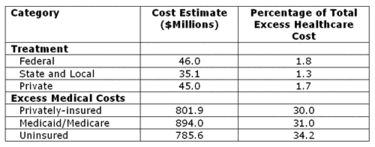STASH Vol. 2(10) – Prescription pain relievers: Friend or foe?
Prescription pain reliever abuse (e.g., opioids: RxO) is a rapidly growing public health concern in the United States. Use of RxOs is a medical treatment to help individuals manage pain; however, nonmedical use and abuse of RxOs is increasing (Paulozzi, Budnitz, & Yongli, 2006). According to National Survey of Drug Use and Health (NSDUH) data, between 1992 and 1998, 4 to 5 million Americans used RxO for nonmedical purposes during each of those years. These users increased in number to 6.5 million during 1999 and to 8.4 million by 2001 (Substance Abuse and Mental Health Services Administration, 2006). This week’s STASH reviews Birnbaum et al.’s (2006) study, which examined the healthcare costs associated with RxO abuse.
Using Treatment Episode Data Sets (TEDS), collected from state-licensed treatment facilities, researchers observed that there were approximately 50,000 individuals admitted for treatment of RxO abuse during 2001. To assess healthcare costs, researchers considered both treatment costs and excess costs. Treatment costs are any costs related to treatment for RxO abuse. Excess costs are medical costs, other than treatment, that are due to RxO abuse.
To calculate treatment costs, the researchers used publicly available information about federal, state, and private expenditures on substance abuse treatment. They then multiplied those substance abuse treatment expenditure by the ratio of RxO treatment admissions to all substance abuse admissions (from the TEDS data sets) to estimate the amount attributable to RxO treatment costs.
To calculate excess medical costs, the researchers first used a large private insurance database to determine the non-treatment costs incurred by identified RxO abusers in that data set compared to those incurred by other insured individuals. They then multiplied that per person excess cost estimate by the number of privately insured RxO abusers (estimated using TEDS). They used publicly available information about Medicaid and uninsured costs (compared to private insurance costs) and TEDS information to obtain similar estimates for publicly insured and uninsured RxO abusers.
Researchers estimated the total healthcare costs of RxO abuse to be $2.6 billion. Total treatment costs during 2001 were more than $126 million. Of these treatment costs, public funds (i.e., from federal and state/local spending) covered approximately 64%. The excess medical costs due to RxO abuse were more than $2.4 billion. Of these excess costs, researchers estimated that public funds (i.e., publicly-insured and uninsured) covered 66% of these costs. (See Table 1).
Figure. RxO abuse excess healthcare cost estimates, 2001, United States (Adapted from Birnbaum et al., 2006). Click image to enlarge.
The datasets that researchers employed in this study had potential limitations. The TEDS dataset might overestimate RxO abuse treatment admissions because of clinician reporting bias. For example, recent press attention about RxO abuse might lead clinicians to increasingly label admissions as RxO abuse. Alternatively, these data might (1) lead to underestimates of RxO abuse and (2) not be representative of the larger population because the TEDS data only represents individuals seeking treatment at state licensed facilities. Finally, the number of assumptions researchers had to make when calculating estimates may have caused inaccuracies in the results due to the differences between the populations and datasets.
Despite these limitations, this study represents the first estimate of treatment costs for RxO abuse in the United States. Because the number of opioid prescriptions have increased in the past decade, many more people have access and exposure to opioids than ever before (Gilson, Ryan, & Jornson, 2004). This increase in access might lead to an increase in RxO abuse and therefore an increase in excess healthcare costs. Future studies should examine the efficacy of various strategies to prevent RxO abuse and provide cost-effective treatment for people who abuse RxOs. Finally, despite the negative consequences that can result from RxO abuse, when used properly, opioids allow individuals with chronic pain to experience a higher quality of life. Therefore, when trying to curb RxO abuse, it is important to recognize the risks and benefits of RxOs and ensure that individuals who truly need these drugs still have access to them.
What do you think? Please use the comment link below to provide feedback on this article.
References
Birnbaum, H. G., White, A. W., Reynolds, J. L., Greenberg, P. E., Zhang, M., Vallow, S., et al. (2006). Estimated Costs of Prescription Opioid Analgesic Abuse in the United States in 2001. Clinical Journal of Pain, 22(8), 667-676.
Gilson, A. M., Ryan, K. M., & Jornson, D. E. (2004). A reassessment of trends in the medical use and abuse of opioid analgesics and implications for diversion control:1997-2002. Journal of Pain Symptom Management, 28, 176-188.
Paulozzi, L. J., Budnitz, D. S., & Yongli, X. (2006). Increasing Deaths from opioid analgesics in the United States. Pharmacoepidemiology and Drug Safety, 15, 618-627.
Substance Abuse and Mental Health Services Administration. (2006). Office of Applied Studies. Detailed Tables for The National Survey on Drug Use and Health. Retrieved November 13, 2006, from
http://www.oas.samhsa.gov/WebOnly.htm#NHSDAtabs
